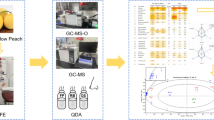Abstract
Introduction
The flavor of Szechuan pepper plays an important role in Sichuan cuisine, where it is responsible for the tingling and numbing characteristic. The aims of this study were to characterize and identify aroma-active compounds of Szechuan pepper and to evaluate changes in flavor components between room and high temperature (ca. 70–80 °C).
Methods
Solvent-assisted flavor evaporation (SAFE) and headspace solid-phase microextraction (HS-SPME) followed by gas chromatography-mass spectrometry (GC-MS) and gas chromatography-olfactometry (GC-O) were used.
Results
In this study, linalool, linalyl acetate, and limonene were identified as the major components by both SAFE and HS-SPME. Seven compounds, namely myrcene, limonene, 1,8-cineole, linalool, 2-phenylethanol, 4-methylacetophenone, and trans-carveol, were identified as aroma-active compounds using GC-O. The most intense aroma-active compounds were 1,8-cineole and linalool. Moreover, 2-phenylethanol and 4-methylacetophenone were identified as aroma-active components for the first time in Szechuan pepper. The relative contents of 1,8-cineole, linalool, 2-phenylethanol, 4-methylacetophenone, and trans-carveol were significantly increased as simulated cooking temperature increased from 40 to 75 °C, whereas myrcene, limonene, and hexanal were significantly decreased; 1,8-cineole was not detected at 40 °C but was detected at 75 °C.
Conclusions
A total of 83 volatile compounds were identified, including 62 by SAFE and 57 by HS-SPME. Of these, 34 volatile compounds were identified by both SAFE and HS-SPME. For the first time, 2-phenylethanol and 4-methylacetophenone were identified as key aroma-active components in Szechuan pepper. The overall flavor of Szechuan pepper might be influenced by a result of the relative ratios of key aroma-active components. Cooking temperature should be taken into consideration when Szechuan pepper is used as an ingredient in food.
Implications
These results could be beneficial for furthering our understanding of aroma-active compounds in Szechuan pepper and improving dishes prepared with this ingredient.

Similar content being viewed by others
References
Baek HH, Kim HJ (2004) Solid phase microextraction-gas chromatography-olfactometry of soy sauce based on sample dilution analysis. Food Sci Biotechnol 13:90–95
Bartley JP (1988) Volatile flavours of Australian tropical fruits. Biol Mass Spectrom 16:201–205
Bautista DM, Sigal YM, Milstein AD, Garrison JL, Zorn JA, Tsuruda PR, Nicoll RA, Julius D (2008) Pungent agents from Szechuan peppers excite sensory neurons by inhibiting two-pore potassium channels. Nat Neurosci 11:772–779
Bryant BP, Mezine I (1999) Alkylamides that produce tingling paresthesia activate tactile and thermal trigeminal neurons. Brain Res 842:452–460
Diao WR, Hu QP, Feng SS, Li WQ, Xu JG (2013) Chemical composition and antibacterial activity of the essential oil from green huajiao (Zanthoxylum schinifolium) against selected foodborne pathogen. J Agric Food Chem 61:6044–6049
Gauvin A, Lecomte H, Smadja J (2004) Comparative investigations of the essential oils of two scented geranium (Pelargonium spp.) cultivars grown on Reunion Island. Flavour Frag J 19:455–460
Grosch W (1993) Detection of potent odorants in foods by aroma extract dilution analysis. Trends Food Sci Technol 4:68–73
Hua D, Xu P (2011) Recent advances in biotechnological production of 2-phenylethanol. Biotechnol Adv 29:654–660
Kang KM, Baek HH (2014) Aroma quality assessment of Korean fermented red pepper paste (gochujang) by aroma extract dilution analysis and headspace solid-phase microextraction-gas chromatography-olfactometry. Food Chem 145:488–495
Lucero ME, Estell RE, Fredrickson EL (2003) The essential oil composition of Psorothamnus scoparius (A. Gray) Rydb. J Essent Oil Res 15:108–111
Seo WH, Baek HH (2009) Characteristic aroma-active compounds of Korean perilla (Perilla frutescens Britton) leaf. J Agric Food Chem 57:11537–11542
Wang S, Xie J, Yang W, Sun B (2011) Preparative separation and purification of alkylamides from Zanthoxylum Bungeanum Maxim by high-speed counter-current chromatography. J Liq Chromatogr Relat Technol 34:2640–2652
Xiang L, Liu Y, Xie C, Li X, Yu Y, Ye M, Chen S (2016) The chemical and genetic characteristics of Szechuan pepper (Zanthoxylum bungeanum and Z. armatum) cultivars and their suitable habitat. Frontiers in. Plant Sci 7:467
Xu Y, Fan W, Qian MC (2007) Characterization of aroma compounds in apple cider using solvent-assisted flavor evaporation and headspace solid-phase microextraction. J Agric Food Chem 55:3051–3057
Yang X (2008) Aroma constituents and alkylamides of red and green huajiao (Zanthoxylum bungeanum and Zanthoxylum schinifolium). J Agric Food Chem 56:1689–1696
Yang Z, Gong J, Zhang L, Du R, Xie J, Sun B (2014) Study on aroma-active compounds in Han Yuan red pepper and Jin Yang green pepper. J Chin Inst Food Sci Technol 14:226–230
Zhao ZF, Zhu RX, Zhong K, He Q, Luo AM, Gao H (2013) Characterization and comparison of the pungent components in commercial Zanthoxylum bungeanum oil and Zanthoxylum schinifolium oil. J Food Sci 78:1516–1522
Author information
Authors and Affiliations
Corresponding authors
Ethics declarations
Funding
This study was funded by the Young Scientist Exchange Program between the Republic of Korea and the People’s Republic of China (2015), the Innovation Promotion in Ability Project (2016GXTZ-008, 2016QNJJ-020, 2017LWJJ-010), and the Youth Fund of Sichuan Province (2016JQ0048).
Conflict of Interest
The authors declare that they have no conflict of interest.
Ethical Approval
This article does not contain any studies with human participants or animals performed by any of the authors.
Informed Consent
Informed consent was obtained from all individual participants included in the study.
Additional information
Highlights
SAFE and HS-SPME followed by GC-O were used to identify and evaluate the flavor changes in Szechuan pepper.
For the first time, 2-phenylethanol and 4-methylacetophenone were identified as key aroma-active components in Szechuan pepper.
The relative contents of 1,8-cineole, linalool, 2-phenylethanol, 4-methylacetophenone, and trans-carveol were significantly increased as cooking temperature increased from 40 to 75°C, whereas myrcene, limonene, and hexanal were significantly decreased.
Rights and permissions
About this article
Cite this article
Li, Z., Jeon, J., Kwon, S.Y. et al. Characterization and Evaluation of Changes in the Aroma-Active Components in Szechuan Pepper (Zanthoxylum bungeanum Maxim) Under Different Cooking Temperatures Using Gas Chromatography-Olfactometry. Chem. Percept. 12, 32–39 (2019). https://doi.org/10.1007/s12078-018-9249-7
Received:
Accepted:
Published:
Issue Date:
DOI: https://doi.org/10.1007/s12078-018-9249-7




